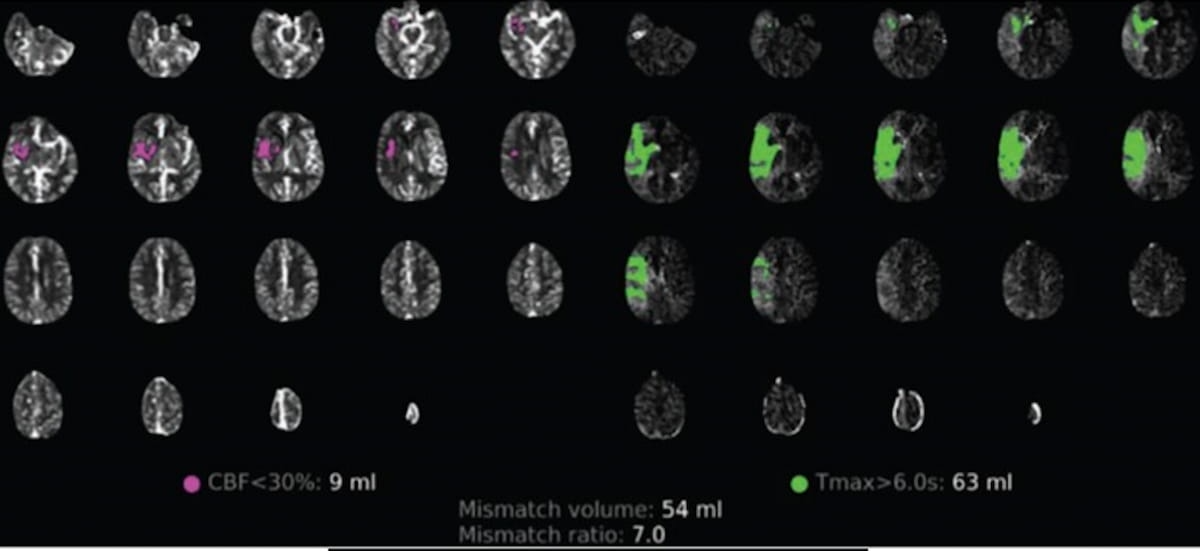CT Study Examines Post-Reperfusion Infarction Growth in Vaccine-Naive Patients with COVID-19
Unvaccinated people with COVID-19 who undergo angiographic reperfusion after acute ischemic stroke may have a greater than fivefold risk of continued infarct growth in comparison to unvaccinated people without COVID-19, according to computed tomography perfusion (CTP) and magnetic resonance imaging (MRI) findings from a recently published study.
For unvaccinated patients, COVID-19 may be a significant risk factor for continued infarct growth after undergoing angiographic reperfusion for acute ischemic stroke (AIS).
For the retrospective study, recently published in the American Journal of Roentgenology, researchers compared data from computed tomography perfusion (CTP) imaging for 10 COVID-19 positive patients (mean age of 67) who had AIS versus 144 control AIS patients without COVID-19 (mean age of 71). All of the patients underwent endovascular reperfusion for AIS and the study authors reviewed CTP imaging prior to endovascular reperfusion as well as follow-up imaging, including magnetic resonance imaging (MRI) when it was obtained, according to the study.
The researchers noted that initial CTP imaging prior to reperfusion showed an infarction core of 1.5 mL and total hypoperfusion volume of 85 mL for patients without COVID-19 in comparison to an initial infarction core of 30.5 mL and total hypoperfusion volume of 117 mL for patients with COVID-19.
Post-reperfusion imaging revealed a 77.8 cm3 median final infarction volume (FIV) for patients with COVID-19 in comparison to 18.2 cm3 in the control group without COVID-19. After controlling for glucose level and the expanded treatment in cerebral ischemia (eTICI) score, the study authors said adjusted logistic parametric regression models revealed that COVID-19 was associated with a 5.1 odds ratio for absolute infarct growth of 15 cm3 or greater.
“This study sheds further light on the potentially aggressive nature of AIS in patients with COVID-19, quantified specifically with respect to infarction progression despite angiographic reperfusion. The study, despite the small population, represents a unique view into the potentiation of ischemic injury in patients with COVID-19, as captured during the initial pre-vaccination phases of the pandemic,” wrote lead study author Seena Dehkharghani, M.D., a professor of radiology and neurology, and director of stroke and cerebrovascular imaging at the New York University Langone Medical Center in New York City, and colleagues.
Images courtesy of the American Journal of Roentgenology.

(Editor's note: For related content, see "New Chest CT Study Assesses Impact of COVID-19 Variants and Vaccination Status" and "Should Dual-Source CT be the New Standard for ER CCTA Assessment of Acute Chest Pain?")
The researchers suggested that the study’s “stark quantitative representation of the severity of stroke in patients with COVID-19” may be triggered by a combination of the disease’s impact on the coagulation cascade and immune system.
“Derangement in the coagulation cascade may be accompanied by (or potentially incite or follow) a florid cytokine storm in such patients, underpinning the briskly inflammatory, thrombogenic, and potentially cytotoxic milieu that may exert downstream influence on ischemic neurovascular tissues,” noted Dehkharghani and colleagues.
Beyond the inherent limitations of a retrospective study with a small cohort, the researchers conceded possible patient selection biases given the imbalance between the patients with COVID-19 and the control group. Dehkharghani and colleagues noted the study may not be sufficiently powered to assess sensitivity for covariates such as large vessel occlusion (LVO) location and antecedent risk factors. The lack of direct spatial co-registration between initial perfusion imaging and follow-up CT and MRI exams study authors may be a confounding factor with the reported growth in infarction volumes, according to the study authors.
What is the Best Use of AI in CT Lung Cancer Screening?
April 18th 2025In comparison to radiologist assessment, the use of AI to pre-screen patients with low-dose CT lung cancer screening provided a 12 percent reduction in mean interpretation time with a slight increase in specificity and a slight decrease in the recall rate, according to new research.
The Reading Room: Racial and Ethnic Minorities, Cancer Screenings, and COVID-19
November 3rd 2020In this podcast episode, Dr. Shalom Kalnicki, from Montefiore and Albert Einstein College of Medicine, discusses the disparities minority patients face with cancer screenings and what can be done to increase access during the pandemic.
Can CT-Based AI Radiomics Enhance Prediction of Recurrence-Free Survival for Non-Metastatic ccRCC?
April 14th 2025In comparison to a model based on clinicopathological risk factors, a CT radiomics-based machine learning model offered greater than a 10 percent higher AUC for predicting five-year recurrence-free survival in patients with non-metastatic clear cell renal cell carcinoma (ccRCC).
Could Lymph Node Distribution Patterns on CT Improve Staging for Colon Cancer?
April 11th 2025For patients with microsatellite instability-high colon cancer, distribution-based clinical lymph node staging (dCN) with computed tomography (CT) offered nearly double the accuracy rate of clinical lymph node staging in a recent study.